What woodpeckers can you see in Spain? There are 8 different species of woodpecker that you might encounter in Spain. Read this article to see pictures, hear their sound and get great information about where and when you can spot all woodpeckers in Spain.
Spain, a land of passionate flamenco, sun-soaked coasts, and rich history, is also a treasure trove of biodiversity. Beyond the bustling cities and iconic landmarks lies a natural world pulsating with life, where the rhythmic drumming of woodpeckers provides a heartbeat to the sprawling woodlands. These avian percussionists, with their distinctive calls and vibrant palettes, are emblematic of the Iberian Peninsula’s wild charm. Join us as we embark on a journey through Spain’s forests and meadows, discovering the magnificent woodpeckers that call this land home, and understanding their unique roles in the intricate dance of nature
Let’s jump into the article.
1. Levaillant’s Woodpecker
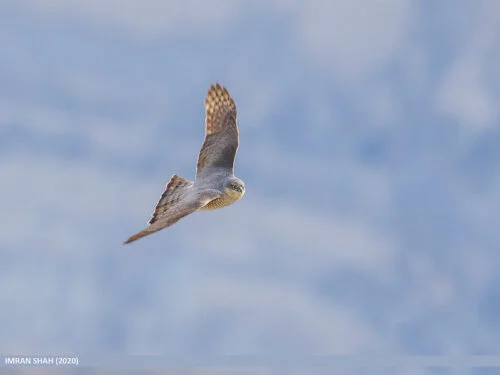
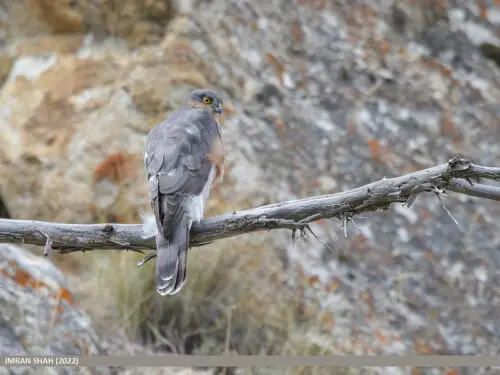
The Levaillant’s Woodpecker is a rare and exotic thread, weaving tales of North African origins and Mediterranean mystique. Named in honor of the French explorer François Levaillant, this bird’s presence in the Iberian Peninsula is as much a story of geographical wonders as it is of avian elegance.
Decked in an intricate palette of greenish hues, the Levaillant’s Woodpecker embodies a kind of sylvan grace. The male is especially captivating with a vivid crimson patch on the forehead, which the females lack. Their speckled underparts and mottled wings give them a unique appearance, setting them apart from their European counterparts.
This woodpecker’s story in Spain is intrinsically tied to the southern reaches of the country, especially the wooded pockets near the Strait of Gibraltar. Its preferred habitats are Mediterranean forests, with a penchant for cork oak groves that echo its North African roots.
Armed with a sharp beak and an even sharper sense of where to find food, the Levaillant’s Woodpecker is an adept hunter. Its diet is varied, consisting of insects, larvae, and the occasional fruit, plucked with precision from the tree barks or ground.
The bird’s presence in Spain is sporadic and relatively less documented compared to its North African stronghold. However, for the birdwatcher with patience and a bit of luck, spotting this woodpecker is a true badge of honor. The serene forests of Andalusia, with their sun-dappled clearings and gentle whispers of ancient tales, are your best bet.
Encountering the Levaillant’s Woodpecker in Spain is a bridge between continents, a testament to nature’s ability to blur boundaries and weave tales of wonder. In the dappled shade of Spanish woods, each drumming note of this bird is a reminder of the intricate dance of ecosystems, geography, and the timeless allure of discovery.
2. Middle Spotted Woodpecker
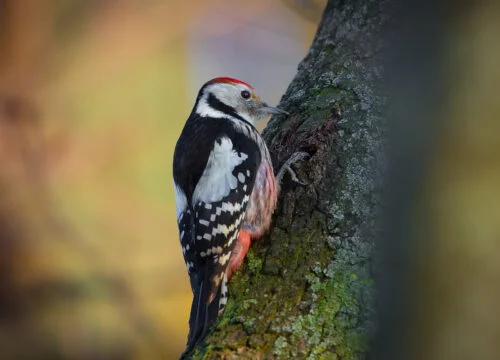
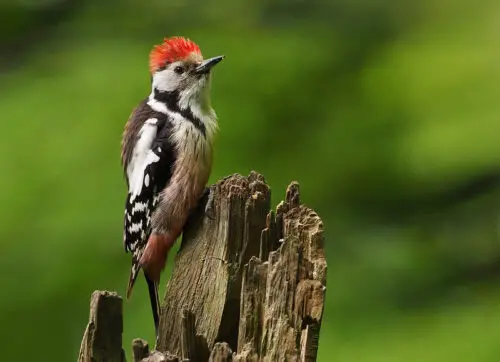
The Middle Spotted Woodpecker stands as a delightful mosaic of patterns and sounds. While Spain’s woodlands resonate with various woodpecker rhythms, the distinct drumming of this particular species is a heartwarming reminder of nature’s diversity in the Iberian landscape.
A visual feast, the Middle Spotted Woodpecker, is slightly smaller than its more renowned cousin, the Great Spotted Woodpecker. Donned in a freckled white underside and crisply patterned black and white wings, it’s the bird’s head that truly captures attention. A delightful wash of crimson caps its crown, imparting a regal aura to its appearance.
Favoring deciduous forests, especially those dominated by oak, hornbeam, and alder, this woodpecker finds solace in the lush, undisturbed patches of Spanish woodland. As one ventures through the northern regions of Spain, especially areas like the Pyrenees and the Cantabrian Mountains, chances of an encounter with this spotted wonder increase.
Adept at foraging, its diet is a smorgasbord of insects, particularly beetle larvae hidden beneath the bark. While the bird’s drumming often gives away its presence, observing its feeding antics — the delicate dance of hopping along branches and pecking at tree trunks — is a spectacle in itself.
If romance were to be avian, the Middle Spotted Woodpecker’s courtship would be a ballet of sounds and aerial displays, replete with synchronized drumming duets and graceful flights.
Spotting the Middle Spotted Woodpecker in Spain is akin to uncovering a hidden treasure, a gem amidst the rich biodiversity. It serves as a gentle reminder that even in the most familiar of landscapes, there’s always something unique waiting to be discovered, echoing the endless mysteries of the natural world.
3. White-backed Woodpecker
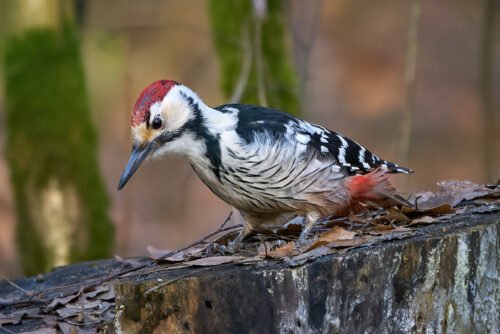
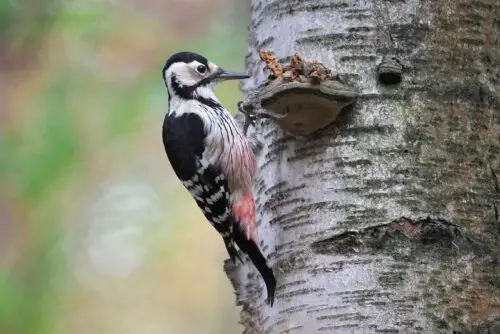
The White-backed Woodpecker is something of a Spanish enigma. Largely elusive but utterly captivating, it is a species often sought after by avid birdwatchers journeying through Spain’s diverse habitats.
Cloaked primarily in black and white, the White-backed Woodpecker’s plumage is an elegant display of contrasts. The males are particularly striking, bearing a rich red crown that contrasts beautifully with the bird’s predominantly white back from which it derives its name. Females, while lacking the bold crimson headgear, are no less appealing in their monochromatic elegance.
Their chosen haunts are typically mature, deciduous forests with plenty of dead or decaying trees. Such habitats, rich in insects, offer a veritable feast for these woodpeckers. As they flit from tree to tree, their distinctive drumming punctuates the air, a rhythm that has become synonymous with the deeper, untouched parts of Spanish woodland.
Spain’s northern regions, particularly areas adjoining the Pyrenees, are some of the prime locales to potentially spot these woodpeckers. Here, amidst the old-growth forests, they hunt for their favorite delicacies: beetle larvae, ants, and other small insects, extracting them with precision from beneath the bark.
The White-backed Woodpecker’s presence in Spain’s forests is not just a delight for birdwatchers but an indicator of the health and age of the woodlands. Their preference for older forests makes their sightings a testament to the preservation of such habitats.
In essence, the White-backed Woodpecker serves as a beautiful reminder of nature’s delicate balance and the importance of conservation. To encounter one in the wild is to touch a piece of Spain’s ancient natural heritage, a legacy that rustles in the leaves and echoes in the rhythmic drumming of this remarkable bird.
4. Great Spotted Woodpecker
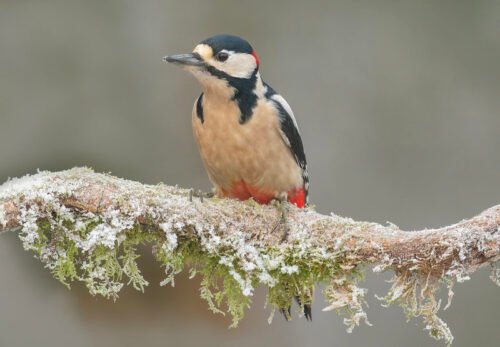
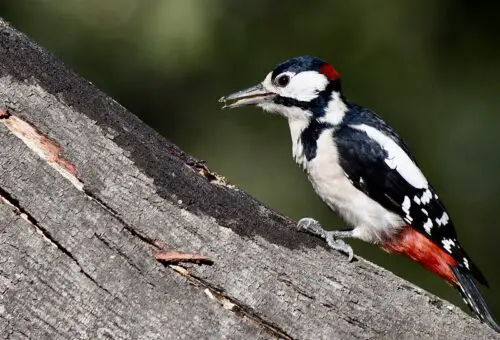
The Great Spotted Woodpecker stands out like a masterful percussionist holding court. Undeniably one of the most recognizable woodpeckers of Europe, its presence in Spain adds a rhythmic heartbeat to the country’s rich avian symphony.
Visually, the Great Spotted Woodpecker is a striking blend of contrasts. Its bold black wings are punctuated with large white patches, and its white underparts are juxtaposed against the dramatic black striping that runs down its flanks. And as if painted by an artist’s brush, a vivid red patch graces the vent area. Males carry an added touch of flamboyance with a red patch on the nape.
The Great Spotted Woodpecker is relatively versatile in its habitat choices, favoring both deciduous and coniferous woodlands. From the dense forests of Andalusia to the more temperate expanses of Catalonia, these birds showcase their adaptability, making their presence known far and wide.
Their diet is as diverse as their habitat range, from insects hidden deep within tree barks to seeds and nuts. They’re particularly fond of raiding the nests of other birds for eggs and chicks, showcasing their opportunistic side.
Spain’s mosaic of landscapes provides numerous opportunities to witness these woodpeckers. Whether it’s the rhythmic drumming echoing through the woods, a fleeting shadow darting between trees, or the full spectacle of its feeding antics high up in the branches, the Great Spotted Woodpecker continually enchants its audience.
In essence, this bird bridges the gap between the familiar and the extraordinary. While it might be one of the more commonly sighted woodpeckers in Spain, each encounter is a fresh dive into wonder, a reminder of the countless stories unfolding in the heart of Spain’s wild realms.
5. Lesser Spotted Woodpecker
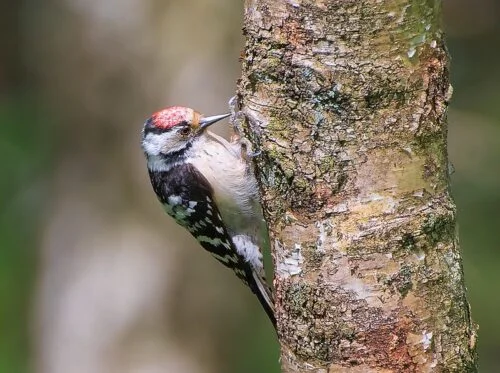
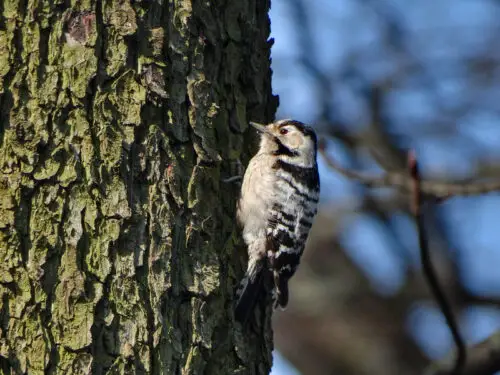
The Lesser Spotted Woodpecker flits about as a delicate secret, a diminutive wonder that beckons true bird enthusiasts with its subtle charm.
A pocket-sized version of its larger counterpart, the Great Spotted Woodpecker, this bird is a delightful blend of subtlety and sophistication. Its plumage, a delicate mix of white and soft black, is elegantly patterned, while a delightful splash of red on the head (in males) offers a surprising pop of color. The females and juveniles wear a more understated palette, devoid of the red, but no less enchanting.
Preferring the tranquility of deciduous forests, particularly those dotted with alder, birch, and willow, the Lesser Spotted Woodpecker can occasionally be seen — or more often heard — in the wooded regions of northern and central Spain. Its drumming, softer and more rapid than its larger relatives, often serves as the first clue to its presence.
In their relentless quest for food, these woodpeckers skillfully navigate the tree bark, searching for their favored diet of insects and larvae. Their foraging techniques, a mix of delicate pecking and adept probing, highlight their precision and adaptability.
Despite its size, the Lesser Spotted Woodpecker’s life in the Spanish woods is filled with drama — territorial disputes, aerial displays during courtship, and the never-ending hunt for food. These birds, though small, play a significant role in the health of their woodland habitats, controlling insect populations and maintaining a balanced ecosystem.
Discovering the Lesser Spotted Woodpecker in Spain’s vast forests is akin to finding a hidden gem. Each sighting or serendipitous auditory encounter with its soft drumming serves as a heart warming reminder of the myriad small wonders that grace the Spanish wilderness, waiting to be unveiled by those patient enough to seek them out.
6. Eurasian Green Woodpecker
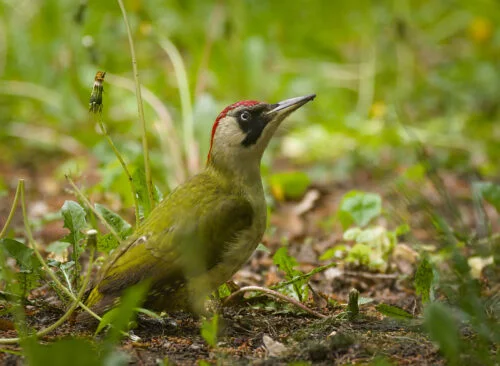
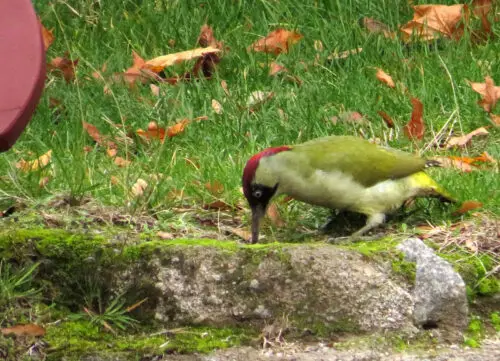
Drenched in the hues of verdant meadows, the Eurasian Green Woodpecker is a radiant presence in Spain’s avian tableau. This bird, with its bright plumage and infectious laughter-like calls, is a delightful blend of whimsy and wilderness, bringing a touch of the forests’ heart to the Spanish landscapes.
Bedecked in a rich green cloak, this woodpecker’s attire is tailored to perfection by nature itself. The top of its head sports a radiant crimson, a crown fit for avian royalty. Males wear an additional red ‘mustache’ streak, adding a touch of flamboyance to their visage, while the females exhibit a more understated, black streak.
Widespread across the Iberian Peninsula, the Eurasian Green Woodpecker has a certain fondness for open woodlands and forest clearings. Its distribution in Spain is broad, encompassing the dense forests of Catalonia, the rolling landscapes of Castilla y León, and even the sun-kissed groves of Andalusia.
Feeding primarily on ants, this woodpecker is often seen on the ground, a behavior quite unusual for its kind. With a specialized tongue, it deftly extracts ants and their larvae from their nests, delighting in a feast that is both nutritious and abundant.
But it’s not just its striking appearance or ground-feeding antics that make this bird noteworthy.
The Eurasian Green Woodpecker’s call — a loud, laughing ‘yaffle’ — echoes through the Spanish woods, adding a touch of joy and mystery to one’s explorations.
In the Spanish cultural landscape, where every creature, every song, and every flutter has a story, the Eurasian Green Woodpecker is a vibrant chapter. It reminds us of the magic that exists in everyday moments, in the laughter of the woods, and the dance of shadows on a sunlit clearing. For those wandering through Spain’s diverse habitats, the call of this woodpecker is both a welcome and an invitation to discover the tales of the land.
7. Iberian Green Woodpecker
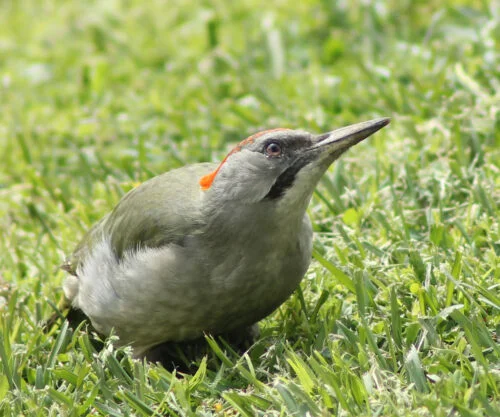
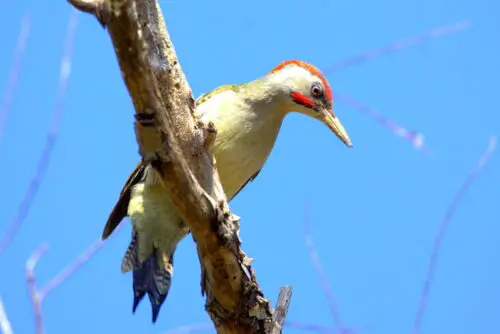
An emblem of Iberian splendor, the Iberian Green Woodpecker dances through the Spanish landscapes with a charisma unique to its lineage. Bearing the legacy of the land it inhabits, this bird is a whisper of the ancient woods and a vibrant testament to Spain’s natural wonders.
The Iberian Green Woodpecker’s plumage is a radiant tapestry of olive-green, with nuances that seem to capture the very essence of Spanish woodlands. A fiery red crown graces both males and females, while the former boasts a striking black mustache streak with hints of red. It’s a bit like nature’s own take on the passionate flair of Spanish flamenco dancers!
Endemic to the Iberian Peninsula, this woodpecker is truly Spain’s very own. Its presence is most pronounced in the woodlands and forests of northern and central Spain, but its calls and drumming echo throughout various parts of the country, each note a song of the wild.
Like its close relative, the Eurasian Green Woodpecker, this bird too has a pronounced appetite for ants. It can frequently be seen foraging on the ground, its long tongue darting with precision to capture ants and larvae. But beyond its diet, the Iberian Green Woodpecker’s behaviors, its mating rituals, and nesting preferences are captivating vignettes of avian life in Spain.
The Iberian Green Woodpecker is more than just a bird; it’s a symbol of the region’s biodiversity. Its song, a sharp series of notes followed by a distinct laugh, is a reminder of the untamed, of stories whispered through the ages by the winds of the Iberian Peninsula.
For travelers, birdwatchers, and anyone with a penchant for nature’s wonders, an encounter with the Iberian Green Woodpecker is like touching a piece of Spain’s wild soul. Every flutter, every call is a melody of heritage and a dance of the timeless Spanish wilderness.
8. Black Woodpecker
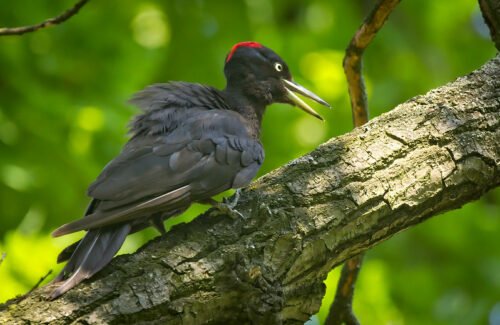
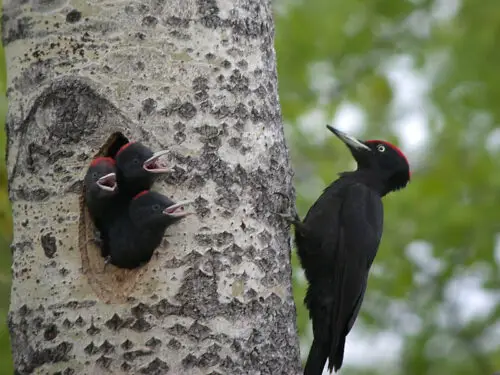
In the variegated avian mosaic of Spain, the Black Woodpecker is a bold stroke of monochrome majesty. This imposing bird, with its glossy black feathers and evocative calls, conjures a sense of the primeval, a living ode to Spain’s ancient forests and their whispered tales.
Swathed in a deep, velvety black, the Black Woodpecker is the largest of its kind in Europe. Its size is not its only defining feature, though; the vibrant crimson cap that both males and females sport adds a touch of drama to its already arresting appearance. Males boast a larger red patch extending from the forehead to the nape, while females have a more subdued crest confined to the back of their heads.
Predominantly inhabiting the northern stretches of Spain, this woodpecker has a particular penchant for mature, dense forests – the older and quieter, the better. These vast expanses of pine, oak, and beech trees are the perfect backdrop to the bird’s deep, resonant drumming, a sound that can reverberate through the woods and command the attention of all who hear it.
With powerful beak blows, the Black Woodpecker can carve out large cavities in trees, both as nesting sites and in search of its primary diet – wood-boring insects, larvae, and other hidden forest critters. Their role in the ecosystem is vital, as the holes they leave behind often become shelters for various woodland species.
The Black Woodpecker’s presence in Spain is emblematic of the country’s pristine and untouched habitats. Its call, a far-carrying, plaintive ‘kraa-kraa-kraa’, is an evocative sound, reminiscent of ancient woodland spirits calling out through time.
To witness this magnificent bird in its natural setting is to experience a piece of Spain’s wild heart. It stands as a testament to the country’s commitment to conservation, and to the intricate tapestry of life that thrives in its forests. Every flap of its wings, every echo of its call, is a song of wilderness, of nature in its purest form.
